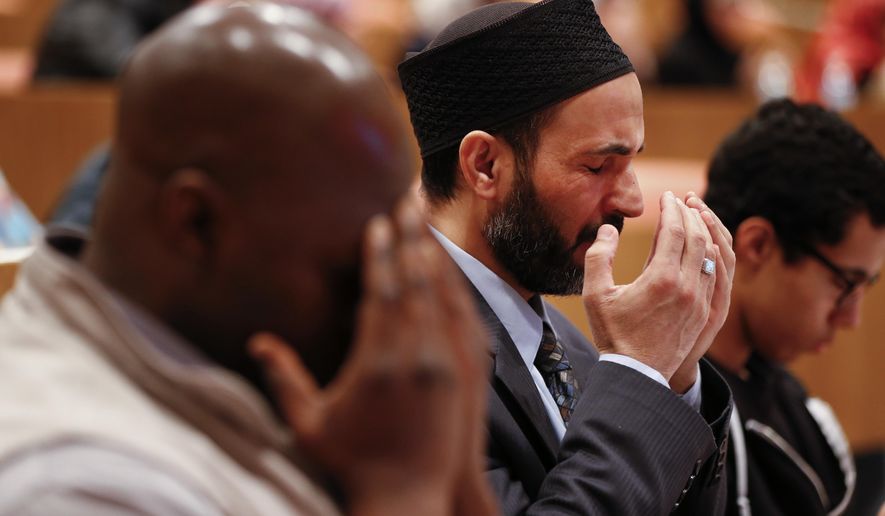Harris Zafar, an Ahmadiyya Muslim author and speaker who often sports a “Talk to a Muslim” T-shirt, is thinking about the image of his faith as the twentieth anniversary of 9/11 approaches.
“I think a lot of progress has been made over the past 20 years,” said Mr. Zafar, national spokesman for the Ahmadiyya Muslim community whose U.S. headquarters is in Silver Spring, Maryland.
After the terrorist attacks linked to violent jihad, the Ahmadis, as they’re known, intensified efforts to demonstrate that the terrorists do not represent genuine Islam.
“But also it feels like you’re trying to clear out a forest, and every time you think you got to the last row of trees, and you look up and you just found a whole new horizon full of trees,” he added.
The Ahmadiyya movement is a controversial subset of Islam’s Sunni branch, which makes up between 85% and 90% of the world’s Muslims.
Established in 1889 by Mirza Ghulam Ahmad, who announced himself to be the Mahdi, or “guided one” and the final Messiah prophesied in the Koran, those pronouncements sparked controversy from the start. Not all Sunnis accepted this announcement, and Ahmadis have faced persecution in many nations including Pakistan, Indonesia, Egypt, and Saudi Arabia.
The group says it “is the only Islamic organization to endorse the separation of mosque and state” in each of the 213 nations where it operates.
The Ahmadis came to America in 1920, and claim to be “the oldest and longest-running Muslim organization in the United States,” Mr. Zafar said. The group has 65 chapters across the country, he noted, and 56 formal mosques including the Bait-ur-Rahman Mosque in Silver Spring. They also operate a website, TrueIslam.com, that promotes their views.
The justifiable outrage Americans felt over the hijacking of four commercial aircraft, three of which struck the World Trade Center in New York and the Pentagon (a fourth crashed in Shanksville, Pennsylvania, after passengers attacked the terrorists onboard) quickly morphed into attacks on Muslim Americans and even people mistakenly believed to be Muslim, such as turban-clad Sikhs, members of a religion unrelated to Islam.
That expression of prejudice, the Ahmadiyya spokesman said, spurred the group to action.
“Animosity against Muslims then was on the rise. I think that naturally spurred the desire for people to want to do interfaith dialogue,” Mr. Zafar recalled. “That’s an important discussion to have, and it culminated over many years into it in 2010, when we launched our first nationwide campaign, an initiative that we called Muslims for Peace.”
The Ahmadis, who claim 25,000 members in the U.S. and “tens of millions” worldwide, handed out “millions upon millions of flyers, hand-to-hand, messages of anti-terrorism, in favor of peace,” Mr. Zafar said. He said the conversations inspired by the leafleting campaign allowed Ahmadis to explain that “a requirement of Islam is to be loyal to the country in which you live.”
In 2010, the Ahmadis launched a “Muslims for Life” campaign of blood donations, “a commitment that every year on September 11, we’re going to now host blood drives around the country as a way to honor the lives lost on 9/11. So [on] the day that took 3,000 lives, let’s save at least 10 times as many lives every single year, during the month of September.” he said.
“We want what everyone else wants,” Mr. Zafar said. “We want a peaceful society, we want access to good jobs, and we want real justice for people of all backgrounds. And we want this country to thrive.”
Although the Ahmadis are a small group within the American Muslim population, their importance shouldn’t be understated, said Craig Considine, a sociology professor at Rice University in Houston, Texas.
Ahmadiyya Muslims, Mr. Considine said, “are proponents of service, of furthering dialogue, furthering knowledge, extending relationships beyond our ‘tribal’ categories.”
He added, “All of those things really resonate with me. I think they’re part of the solution to a lot of what we’re dealing with, in terms of our challenges and problems.”
• Mark A. Kellner can be reached at mkellner@washingtontimes.com.




Please read our comment policy before commenting.